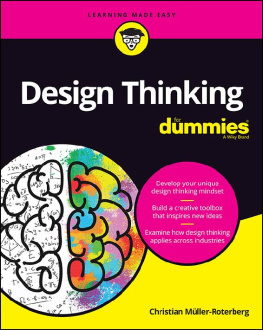Florian Heuer - Design Thinking - Overview, techniques and example workshop
Here you can read online Florian Heuer - Design Thinking - Overview, techniques and example workshop full text of the book (entire story) in english for free. Download pdf and epub, get meaning, cover and reviews about this ebook. year: 2015, publisher: Heuer Coaching, genre: Business. Description of the work, (preface) as well as reviews are available. Best literature library LitArk.com created for fans of good reading and offers a wide selection of genres:
Romance novel
Science fiction
Adventure
Detective
Science
History
Home and family
Prose
Art
Politics
Computer
Non-fiction
Religion
Business
Children
Humor
Choose a favorite category and find really read worthwhile books. Enjoy immersion in the world of imagination, feel the emotions of the characters or learn something new for yourself, make an fascinating discovery.

- Book:Design Thinking - Overview, techniques and example workshop
- Author:
- Publisher:Heuer Coaching
- Genre:
- Year:2015
- Rating:3 / 5
- Favourites:Add to favourites
- Your mark:
- 60
- 1
- 2
- 3
- 4
- 5
Design Thinking - Overview, techniques and example workshop: summary, description and annotation
We offer to read an annotation, description, summary or preface (depends on what the author of the book "Design Thinking - Overview, techniques and example workshop" wrote himself). If you haven't found the necessary information about the book — write in the comments, we will try to find it.
Florian Heuer: author's other books
Who wrote Design Thinking - Overview, techniques and example workshop? Find out the surname, the name of the author of the book and a list of all author's works by series.
Design Thinking - Overview, techniques and example workshop — read online for free the complete book (whole text) full work
Below is the text of the book, divided by pages. System saving the place of the last page read, allows you to conveniently read the book "Design Thinking - Overview, techniques and example workshop" online for free, without having to search again every time where you left off. Put a bookmark, and you can go to the page where you finished reading at any time.
Font size:
Interval:
Bookmark:
Design Thinking in Business and IT
Overview, techniques and example workshop
Design Thinking in Business and IT
Overview, techniques and example workshop
Florian Heuer
2015 Florian Heuer
All rights reserved.
Author: Florian Heuer
info@heuer-coaching.com
ISBN: 978-3-95849-444-2
You mightve talked about innovation with your IT department or software development agency lately and the words design thinking were surely mentioned. So what is it? Just another piece of business jargon to
add to your arsenal or a useful tool? Or maybe even an overestimated hype?
So why consider design thinking?
We all know that the IT and the Business side of most organizations often have a special love-hate relationship. Design thinking might just be the approach to ensure a smoother working process and better results. A healthy atmosphere of collaboration between these departments in any company shouldnt be a challenge to maintain as the organization applies design thinking. This way, IT can contribute with solution implementation and management whereas the commercial department can bring to the table their hands-on requirements.
However, the situation doesnt seem to have changed so much and there are still challenges faced between IT departments and the rest of the company. In some organizations functional departments such as Marketing, Finance or Customer Services are looking at ways to find solutions to their own problems. However, the need for an integrated approach, involving IT, is even greater nowadays. And the requirement doesnt just cover major incidents. Collaboration and dialogue are necessary throughout and thats where Design Thinking can play a major role to resolve the differences and ensure smooth running at every level of the organization.
Nowadays every organization or business runs into a myriad of problems as business models become increasingly more complex. Globalization and advances in communication and technology, all add up to creating unique opportunities but also new challenges that are not easy to solve applying the old tested methods. Thats where design thinking comes into play. So how do we define it?
OK, lets start with a high level definition:
Design thinking is basically a discipline that facilitates innovation and problem solving by taking the human-centered approach and focusing on the needs and wants of the end-user. It follows a string of steps and involves teams with mixed skills and backgrounds so it can combine their different strengths and points of view. Because it brings people in the same environment, with the help of an experienced facilitator, they can establish common ground. The result is that everyones voice will be heard and collaboration is achieved in a fun and informal way. Everyone within the group is encouraged to share their ideas, experiences, skills and expectations so the group can work through the different options following the DT process and collaborate to reach a solution for the problem at hand.
Now lets see what some top influencers in that field have to say about design thinking?
So here are two definitions , the first one from Tim Brown, CEO of the design and innovation company IDEO and the second one from David Kelley , founder of IDEO and Stanford d.school.
According to Tim Brown Design thinking is all about upgrading within constraints.
The other way to describe design thinking is as a process of generating new and innovative ideas for solving problems that can be applied not only to business and IT but to all walks of life. By applying the principles and framework of design thinking, companies and organizations can address complex business issues and challenges and gain a competitive advantage as well.
According to David Kelly , who adapted design thinking for the purposes of business, it uses the designers arsenal to integrate the needs of people, the possibilities of technology, and the requirements for business success. In this way, the approach is focused on the three main elements of a solution or a product, namely people, technology and business with the customer always being at the centre of it all.
Customer focus is key for the success of any business project and this is also ingrained in design thinking where the customer is at the heart of any solution . The multifunctional teams that are at the centre of the approach are all guided by the core values of design thinking which are diversity, empathy and ambiguity (well come back to these later). These principles are not new but with design thinking they become part of a consistent and repeatable process.
As a discipline, design itself lies between science and the humanities. Design thinking as a formal method of problem solving in business and technology focuses on creating solutions starting with the end goal in mind. Alternative solutions are explored at the same time without the fear of failure. Unlike analytical scientific methods, in design thinking any idea is acceptable in the brainstorming or ideation phase which encourages participation and input. The term thinking outside the box was actually coined by design thinking practitioners and it is important as it perfectly describes the fact that brainstorming encourages any idea to be brought into the equation.
Why does it work?
One of the key principles of the DT process is that it leaves the door open to all possibilities until they are proven not to be feasible. Team members work through all the options, the reasonable, the crazy and impossible ones, without prejudice so they can ultimately find the one that works. It could often be the solution that seemed to be just a mad suggestion in the first place but with input from everyone, turned out to be the best solution. And probably the most important part people are encouraged to communicate and interact with each other .
Design thinking really comes into its full potential as a framework for inventiveness and resourcefulness. It makes people excited about new ideas which can lead to creating solutions not only to current and well defined needs, but more importantly to future, yet unmet ones. This often results in outstanding and ground-breaking products and services. To quote Steve Jobs It's really hard to design products by focus groups. A lot of times, people don't know what they want until you show it to them.
This goes to prove that often asking your customers what they want will stifle innovation and result in offering me too products. For example the launch of the iPod changed the entire digital music industry and portable digital electronics market in ways that couldnt have been predicted by doing customer surveys. It wasnt just another mp3 player, it improved on the shortcomings of all existing models and it combined hardware and software (iTunes) which made it easier to use.
Ideas generated through the design thinking method can create the demand for new technology that in its turn will translate into solutions for growth and profitability which is the ultimate measure for success in business and IT.
As we have heard in the previous chapters, the Design Thinking methodology came initially from IDEO and Stanford and was aimed at providing an organized approach to problem solving in general and product and service innovation in particular.
Its main ingredients are a set of team values, recommendations and methods that supports a collaborative and iterative problem solving process, aiming at fuelling innovation. The three most important aspects of design thinking are:
- Desirability What do people desire? This builds on one of the main principles of design thinking the human-centred approach. Innovation needs to be attractive from the users and customers point of view as well as based on teamwork in order to be viable.
Font size:
Interval:
Bookmark:
Similar books «Design Thinking - Overview, techniques and example workshop»
Look at similar books to Design Thinking - Overview, techniques and example workshop. We have selected literature similar in name and meaning in the hope of providing readers with more options to find new, interesting, not yet read works.
Discussion, reviews of the book Design Thinking - Overview, techniques and example workshop and just readers' own opinions. Leave your comments, write what you think about the work, its meaning or the main characters. Specify what exactly you liked and what you didn't like, and why you think so.








![Tracy Fullerton [Tracy Fullerton] - Game Design Workshop, 3rd Edition](/uploads/posts/book/119440/thumbs/tracy-fullerton-tracy-fullerton-game-design.jpg)